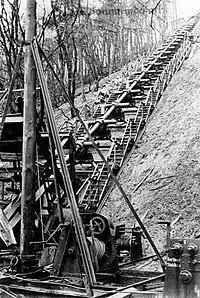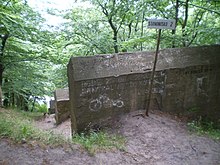This article needs additional citations for verification. (June 2023) |
50°51′15″N 1°45′30″E / 50.85417°N 1.75833°E
| Hochdruckpumpe ("high-pressure-pump")[1] | |
|---|---|
 The prototype V-3 cannon at Laatzig, Germany (now Zalesie, Poland) in 1942. | |
| Type | Large-caliber artillery |
| Place of origin | Germany |
| Service history | |
| In service | 1944–1945 |
| Used by | Germany |
| Wars | World War II |
| Production history | |
| Manufacturer | Krupp[2] |
| Specifications | |
| Length | 130 m (430 ft)[3] |
| Shell | 140 kilograms (310 lb) |
| Caliber | 150 millimetres (5.9 in) |
| Elevation | fixed |
| Traverse | fixed |
| Rate of fire | 0.2 rpm (projected)[4] |
| Muzzle velocity | 1,500 metres per second (4,900 ft/s) |
| Maximum firing range | 165 km (103 miles) |

The V-3 (German: Vergeltungswaffe 3, lit. 'Vengeance Weapon 3') was a German World War II large-caliber gun working on the multi-charge principle whereby secondary propellant charges are fired to add velocity to a projectile. It was built in tunnels and was permanently aimed at London, England.
The Germans planned to use the weapon to bombard London from two large bunkers in the Pas-de-Calais region of northern France, but they were rendered unusable by Allied bombing raids before completion. Two similar guns were used to bombard Luxembourg from December 1944 to February 1945.
The V-3 was also known as the Hochdruckpumpe ("High Pressure Pump," HDP for short), which was a code name intended to hide the real purpose of the project. It was also known as Fleißiges Lieschen ("Busy Lizzie").[5][6]
- ^ Thompson, Peter (1999). The V-3 Pump Gun. London: ISO Publications.
- ^ Henshall 1985, p. 61
- ^ "Fortress de Mimoyecques". theotherside.co.uk. Retrieved 24 December 2007. (bottom of page)
- ^ "V3". History Learning Site. Retrieved 18 November 2020.
- ^ "The V3 weapon system (HDP), "High pressure pump" or "Centipede"". Current museum specials & news. Archived from the original on 22 August 2006. Retrieved 24 December 2007. (bottom of page)
- ^ Dornberger, Walter (1954). V-2. New York: The Viking Press, Inc. p. 216-217.